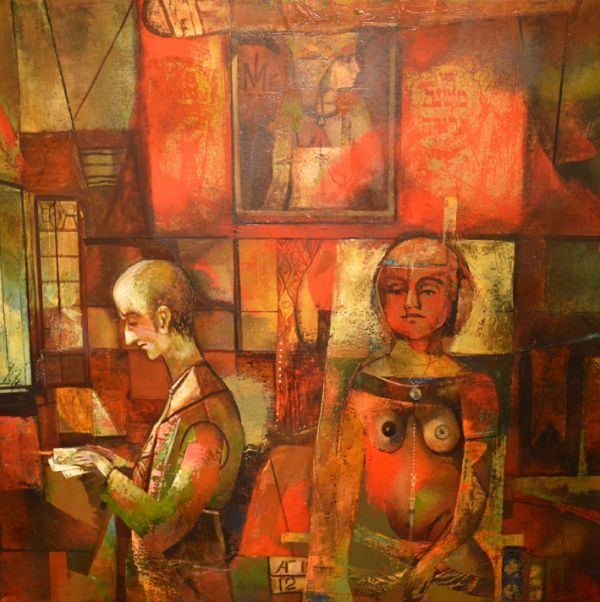Native name Александр Гуревич Name Alexander Gurevich Occupation Painter | Alma mater High Art College Nationality Israeli | |
 | ||
Full Name Alexander Gurevich Website gurevichart.com,http://www.gurevich-art.com/ | ||
Alexander gurevich in cecut 3 27 04
Alexander Gurevich, (born February 7, 1944) is an Israeli painter and graphic artist.
Contents
- Alexander gurevich in cecut 3 27 04
- Alexander gurevich clarinet mendelson
- Biography
- Shot Biography
- Work in the Soviet Union
- Work in Israel
- Works in museums
- Personal exhibitions
- Selected Group Exhibitions
- References

Alexander gurevich clarinet mendelson
Biography
Alexander Gurevich was born in 1944 in Alapaevsk in the Urals, where his parents had been evacuated during the war. After war the family immediately returned to Leningrad, where he first started to develop a sense of himself as a human being and as an artist.Alexander lived in an area that had once been respectable, filled with an eclectic assortment of solidly-built residences where magnificent spacious apartments had been transformed into-anthills of communal apartments of the sort cursed, ridiculed, and extolled by generations of Soviet writers and artists. There were cases of neighbour helping neighbour, and even good influences, since, after all, all layers of society, the most varied of people and objects, were shuffled together and compressed there. Could it be that these very childhood impressions were what produced the richness, almost to the point of overcrowding, in Gurevich’s work? St. Petersburg remained forever engraved in the artist’s work both directly, as a background for his mise en scenes as well as indirectly, through its culture, characterised by intellectualism and fantasy. The Leningrad Electrotechnical Institute where Alexander was accepted had a reputation as one of the “elite” engineering schools, incidentally, this school produced a particularly high numbers of artists. Even camping trips to hard-to-reach parts of the country were a thrilling escape from oppressive ideology. While working as an an engineer, Gurevich began attending the Viborg Art studio, then the Mukhin Leningrad Industrial Arts School, from which he graduated in 1975. Here were a certain degree of freedom, the use of modern styles, and experimentation with form that were not possible with easel painting were allowed in applied arts because they were merely decorative and, most importantly, did not have a place on the ideology front. Even than, Gurevich’s art was a poor fit for official exhibitions - drawings that were alive, far removed from academic art, not reflecting, but, instead, expressing a colour, subject matter that had nothing in common with the stilted content of officially-favored works. And most of all, there was the deeply personal iterpretaton reflected in his work. What remained was the road to unofficial art. The young artist’s first meeting with his public took place at the historic Nevsky Palace of Culture exhibition in 1975. Exhibitions in apartments became more frequent. One of the first ones was the 1975 exhibition of the ALEF Jewish artists group in Evgeny Abezgauz’s apartment, a show Alexander Gurevich also participated in. By the late eighties, Gurevich had become a respected master within underground art, having perfected his style to the level of a perfectly-tuned instrument. He had developed his own subject matter, which touched on society’s most burning problems and own intonation. After all, “the style is the person”. From the article by N. Blagodatov in the book "Alexander Gurevich" 2008, San FranciscoShot Biography
Alexander Gurevich was born in Alapaevsk, Ural (former Soviet Union) where his family stayed during the World War II. Gurevich's parents divorced when he was young; he and his mother returned to her hometown Leningrad when he was 18 months old. He was raised by his grandparents from mother's side. After finishing high school, he attended the then Leningrad Electrotechnical Institute (LETI) (now Saint Petersburg State Electrotechnical University) during 1961-1967, majoring in electronic engineering. Upon graduation Gurevich worked as an engineer for 5 years. In 1971 Gurevich enlisted into High Art College, named Muhina (now Saint Petersburg Art and Industry Academy), from which he graduated 3.5 years later; after earning a degree in Industrial Design. He worked as a decorator for 15 following years, at the same time pursuing his unofficial creative career as an artist.
Work in the Soviet Union
In the 70s Gurevich took part in various exhibitions of unofficial art, as a member of so-called Fellowship of Experimental Art. In 1975 he became a member of Alef group (a group of Jewish artists, founded by Eugene Abeshaus in Leningrad.) Their landmark exhibition, which included the artists Alexander Manusov, Anatoli Basin and Alexander Okun, was viewd by four thousand people in its first week alone. Membership to the Aleph group was dangerous politically, and by 1977 the group disbanded. In 1989 he participated in the Art Festival "Creativity under Duress" in Louisville, Kentucky, USA.
Work in Israel
In 1993 Gurevich together with his family emigrated to Israel. He has been living and working in Jerusalem since then. In 1994 he became a member of the Artists House (Beit Amanim) in Jerusalem. In 2008 an album about his life and art was published by Ruvim Braude in San Francisco, California, USA ("Alexander Gurevich"); with articles by B. Bernstein and N. Blagodatov.
Gurevich has had one-man exhibitions in galleries in the United States, Russia, Germany and Israel.
